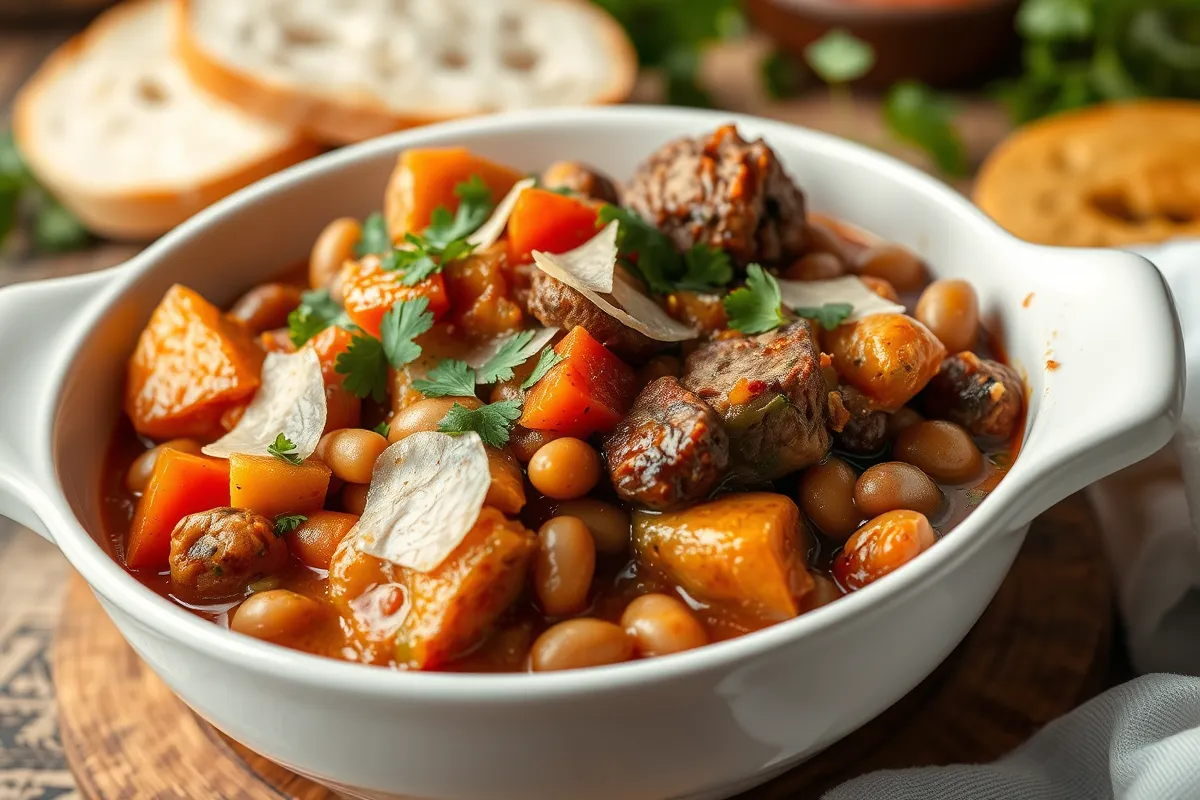Understanding High Protein Slow Cooker Recipes
What Are High Protein Recipes and Why Use a Slow Cooker?
High protein recipes focus on delivering meals rich in proteins, essential for muscle repair, weight management, and overall health. When paired with a slow cooker, these recipes unlock a world of convenience and flavor. The slow cooker method enhances the texture of proteins like chicken,beef, and even plant-based alternatives, making them tender and infused with rich flavors.
Why choose a slow cooker for protein-packed meals?
- Hands-off cooking that suits busy lifestyles.
- Maintains protein integrity without overcooking.
- Great for meal prepping large portions.
For instance, preparing a high-protein chicken chili in a slow cooker not only ensures the beans and chicken remain juicy but also saves time compared to stovetop methods. Explore this guide to slow cookers and their benefits for more.
Benefits of Cooking High Protein Meals in a Slow Cooker
Using a slow cooker offers numerous benefits:
- Nutritional Preservation: Retains the amino acids and nutrients in proteins.
- Time Efficiency: Meals can be cooked overnight or during work hours.
- Flavor Enhancement: The slow cooking process blends spices and proteins, creating deep, robust flavors.
Imagine coming home to a warm, hearty beef and barley stew that’s not just filling but packed with 30g of protein per serving. The low and slow cooking process makes this possible, turning even the toughest cuts of meat into a delicious meal.
Nutritional Importance of High Protein Diets
Protein is the foundation of a healthy diet.
It aids in:
- Muscle growth and repair.
- Weight management, as proteins are satiating.
- Hormone regulation and enzyme function.
Adults typically need about 0.8g of protein per kilogram of body weight. For athletes or those aiming for weight loss, this requirement can rise to 1.2–2.0g per kilogram. Slow cooker recipes, like chicken and white bean soup, can easily meet these dietary needs.
Slow Cooker Essentials for High Protein Recipes
Must-Have Ingredients for High-Protein Meals
Building a high-protein slow cooker meal starts with the right ingredients:
- Proteins: Chicken breast, beef cuts, lentils, tofu, eggs.
- Add-ons: Beans, chickpeas, quinoa.
- Flavor Enhancers: Garlic, onions, and broths.
A simple combination of chicken, black beans, and tomatoes can transform into a protein-packed chili with minimal effort.
Best Types of Proteins for Slow Cookers (Chicken, Beef, Plant-Based)
Not all proteins are slow-cooker-friendly.
- Chicken: Breasts for low-fat options, thighs for tenderness.
- Beef: Brisket, chuck roast, or stew meat are ideal.
- Plant-Based: Lentils, tofu, and tempeh absorb flavors well.
For vegetarian options, consider lentil curry, which is packed with fiber and protein and is a breeze to prepare in a slow cooker. Check out this plant-based protein resource.
Recommended Slow Cooker Models for Protein Cooking
Choosing the right slow cooker enhances your cooking experience. Look for:
- Capacity: 6-quart models work well for families or meal preppers.
- Settings: Keep warm, low, and high settings for versatility.
- Features: Programmable timers and auto shut-off.
Popular models like the Crock-Pot Cook & Carry or Instant Pot Duo make excellent choices.
Planning High Protein Meals
Meal Prep Tips for Slow Cooker Recipes
Meal prepping is key to achieving dietary goals. Slow cookers simplify this process by allowing batch cooking. Here’s how:
- Chop ingredients in advance.
- Pre-portion proteins for recipes.
- Use freezer-safe bags to store uncooked meals.
A well-prepped turkey meatball marinara can go from freezer to cooker, saving time and ensuring a protein-packed lunch.
Adjusting Protein Ratios for Dietary Needs (Athletes, Weight Loss, etc.)
Your protein intake should reflect your goals:
- Athletes: Focus on lean meats and high-protein legumes.
- Weight Loss: Opt for low-fat proteins like chicken and fish.
- Plant-Based Diets: Balance beans, quinoa, and tofu.
For example, a high-protein Buddha bowl with tofu and edamame is perfect for vegetarians seeking a balanced meal.
Safety and Storage Tips
How to Properly Store Cooked High-Protein Meals
Proper storage ensures your meals stay fresh:
- Divide meals into portions and cool before refrigerating.
- Store in airtight containers.
- Consume within 3–4 days or freeze for up to 3 months.
Always label containers with cooking dates to prevent confusion.
Preventing Overcooking or Dryness in Protein Dishes
Avoid common pitfalls like overcooking chicken in a slow cooker. Tips include:
- Add enough liquid (broth or water).
- Use the “low” setting for longer cooking times.
- Check temperatures with a meat thermometer: 165°F for poultry, and 145°F for beef.
High protein slow cooker recipes provide the perfect combination of nutrition and convenience. From meal prepping to maximizing protein intake, slow cookers make healthy eating effortless.
High Protein Breakfast Recipes
Slow Cooker Protein Oatmeal with Peanut Butter and Whey
Kickstart your day with a high-protein breakfast that combines the creaminess of oatmeal with the muscle-building power of whey protein. Preparing oatmeal in a slow cooker creates a creamy texture that’s unparalleled, especially when enriched with ingredients like almond milk and natural peanut butter.
- Ingredients:
- Steel-cut oats (1 cup)
- Almond milk (4 cups)
- Peanut butter (2 tablespoons)
- Whey protein powder (2 scoops)
- Chia seeds (2 tablespoons)
- Preparation: Combine oats, almond milk, and chia seeds in the slow cooker. Cook on low for 6–8 hours. Stir in whey protein and peanut butter just before serving for a warm, hearty meal delivering over 20 grams of protein per serving.
This dish is a breakfast game-changer, providing sustained energy while satisfying your protein needs. Find more whey-based recipe ideas here.
Egg and Sausage Casserole in a Slow Cooker
For a protein-packed breakfast option, an egg and sausage casserole is both versatile and easy to prepare. By layering eggs, turkey sausage, and cheese, you create a meal that’s perfect for feeding a family or meal-prepping for the week.
- Customization Tips:
- Use lean chicken sausage for fewer calories.
- Add spinach or kale for extra nutrients.
- Swap cheese for nutritional yeast if dairy-free.
Vegan Options: Tofu Scramble and Lentils
Vegan breakfasts can also be protein-rich. A slow-cooker tofu scramble with lentils incorporates high-protein tofu crumbles, turmeric, and spices like black salt for an egg-like flavor. Combine this with cooked lentils for a savory, nutrient-dense start to your day.
Hearty Soups and Stews
Chicken and White Bean Chili
Few meals are as comforting and protein-packed as a chicken and white bean chili. The combination of lean chicken breast and protein-rich white beans results in a filling, high-protein dish.
- Ingredients:
- Chicken breasts (1.5 lbs)
- White beans (2 cups)
- Green chilies (1 can)
- Chicken broth (4 cups)
Cooking these ingredients on low for 6–8 hours melds the flavors beautifully. Garnish with cilantro and a dollop of Greek yogurt for extra protein.
Beef and Barley Stew with Extra Protein
This robust stew uses barley—a high-fiber, high-protein grain—and lean beef cuts. By slow cooking, the beef becomes tender while the barley absorbs the broth, resulting in a balanced meal rich in nutrients.
- Add a Twist: Include a cup of lentils or chickpeas for an additional protein boost without altering the classic stew flavor.
Vegetarian Stews Packed with Protein (Quinoa, Chickpeas)
Vegetarians can enjoy protein-packed stews by using quinoa as a base. Quinoa is a complete protein and pairs well with chickpeas, sweet potatoes, and spices like smoked paprika. Cook on low for 6 hours, and you’ll have a comforting, protein-rich dish.
Protein-Packed Lunch Recipes
Slow Cooker Pulled Chicken Sandwiches
These sandwiches are perfect for a quick, satisfying lunch. By slow-cooking chicken breasts in a tangy BBQ sauce, you ensure the meat remains moist and easy to shred. Serve on whole-grain buns or lettuce wraps for a high-protein, low-carb option.
- Pro Tip: Add a splash of apple cider vinegar to enhance flavor and tenderize the chicken.
Turkey Meatball Marinara
Lean turkey meatballs simmered in a rich marinara sauce make an excellent lunch option. The slow cooker ensures the meatballs absorb the flavors while staying moist.
- Serve with:
- Zucchini noodles for a low-carb meal.
- Whole-grain pasta for a more traditional option.
High Protein Buddha Bowl Base Recipes
Base your Buddha bowls on high-protein staples like quinoa or farro. Add slow-cooked proteins such as shredded chicken, baked tofu, or black beans. Customize with veggies, hummus, or a drizzle of tahini dressing.
Dinner Delights
Beef and Sweet Potato Curry
For dinner, a beef and sweet potato curry offers a flavorful way to meet your protein goals. The slow cooker enhances the tenderness of the beef while allowing the sweet potatoes to become melt-in-your-mouth soft.
- Flavor Boost: Use coconut milk and red curry paste for a creamy, aromatic base.
Salmon with Lemon Garlic Sauce in Slow Cooker
Cooking fish in a slow cooker might seem unconventional, but it’s a fantastic way to retain moisture and flavor. Place salmon fillets on a bed of lemon slices, drizzle with garlic butter, and cook on low for 1–2 hours.
Snacks and Small Bites
High Protein Meatloaf Bites
Mini meatloaves prepared in a slow cooker are not only convenient but also versatile. Combine lean ground turkey with oats and egg whites, then mold into small loaves. These bite-sized snacks are perfect for on-the-go protein boosts.
Savory Protein Bars Using Chicken or Beans
Protein bars don’t have to be sweet! Blend cooked chicken or beans with spices, oats, and egg whites to create savory protein bars. These are ideal for athletes needing portable snacks.
Protein-Rich Dips (Hummus, Greek Yogurt Base)
Slow-cooked dips like roasted red pepper hummus or a spinach and artichoke dip using Greek yogurt provide a creative way to incorporate more protein into your day.
From savory breakfasts to hearty dinners and creative snacks, high-protein slow cooker recipes open up endless possibilities for healthy, flavorful meals. Whether you’re preparing a simple chicken chili or experimenting with vegan protein dips, the slow cooker proves itself to be a versatile kitchen tool for any dietary need.

